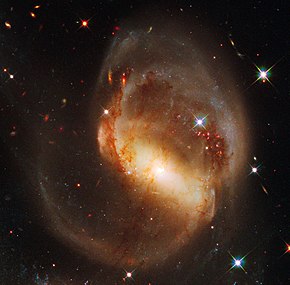NGC 7319
| NGC 7319 | |
|---|---|
 NGC 7319 imaged by the Hubble Space Telescope | |
| Observation data (J2000 epoch) | |
| Constellation | Pegasus |
| Right ascension | 22h 36m 03.56s[1] |
| Declination | +33° 58′ 32.7″[1] |
| Redshift | 0.022[1] |
| Heliocentric radial velocity | 6,740 km/s[2] |
| Distance | 311 Mly (95.3 Mpc)[1] |
| Apparent magnitude (V) | 14.1[3] |
| Characteristics | |
| Type | SB(s)bc pec[3] |
| Apparent size (V) | 1′.7 × 1′.3[3] |
| Other designations | |
| NGC 7319, UGC 12102, LEDA 69269, PGC 69269[4][3] | |
NGC 7319 is a highly distorted barred spiral galaxy that is a member of the compact Stephan's Quintet[5] group located in the constellation Pegasus, some 311 megalight-years distant from the Milky Way.[1] It was discovered on 27 September 1873 by French astronomer Édouard Stephan.[6]
The galaxy's arms, dust and gas have been highly disturbed as a result of the interaction with the other members of the Quintet. Nearly all of the neutral hydrogen has been stripped from this galaxy, most likely as a result of a collision with NGC 7320c some 100 million years ago.[7] A pair of long, parallel tidal tails extend southward from NGC 7319 in the direction of NGC 7320c, and is undergoing star formation.[8]
This is a type 2 Seyfert galaxy[1] with one of the largest circumnuclear outflows known in galaxies of this type. This outflow reaches velocities of up to 500 km/s and spans 13 kly. The star formation rate appears normal for a spiral galaxy at 1.98±0.58 M☉ yr−1, and the majority (68%) is occurring in the spiral arms.[8] The core appears faint in the ultraviolet band, indicating heavy extinction within the active galactic nucleus.[8] There is a three component radio source with an overall size of 5.5 kly that is straddling the nucleus.[9] A strong X-ray source with a high redshift has been detected at a separation of 8″ from the galactic nucleus, a quasi-stellar object.[2]
One supernova has been observed in NGC 7319: On 19 August 1971, Leonida Rosino discovered SN 1971P (type unknown, mag. 16.8).[10]
See also
[edit]References
[edit]- ^ a b c d e f Koss, Michael; et al. (October 2011). "Host Galaxy Properties of the Swift Bat Ultra Hard X-Ray Selected Active Galactic Nucleus". The Astrophysical Journal. 739 (2): 20. arXiv:1107.1237. Bibcode:2011ApJ...739...57K. doi:10.1088/0004-637X/739/2/57. S2CID 118119154. 57.
- ^ a b Galianni, Pasquale; et al. (February 2005). "The Discovery of a High-Redshift X-Ray-Emitting QSO Very Close to the Nucleus of NGC 7319". The Astrophysical Journal. 620 (1): 88–94. arXiv:astro-ph/0409215. Bibcode:2005ApJ...620...88G. doi:10.1086/426886. S2CID 757970.
- ^ a b c d "NASA/IPAC Extragalactic Database". Results for NGC 7319. Retrieved 2007-04-21.
- ^ "NGC 7319". SIMBAD. Centre de données astronomiques de Strasbourg. Retrieved 2020-10-08.
- ^ Di Mille, F.; et al. (October 2008). Funes, José G.; J., S.; Corsini, Enrico Maria (eds.). 3D Spectroscopy of the Nuclear Environment of a Selected Sample of Nearby Active Galactic Nuclei: NGC 7319. Formation and Evolution of Galaxy Disks. Proceedings of the conference held 1–5 October 2007 at the Centro Convegni Matteo Ricci, Rome, Italy. ASP Conference Series. Vol. 396. San Francisco: Astronomical Society of the Pacific. p. 61. Bibcode:2008ASPC..396...61D.
- ^ Seligman, Courtney. "New General Catalogue Objects: NGC 7319". Celestial Atlas. Retrieved 28 August 2024.
- ^ Moles, M.; et al. (August 1997). "The Dynamical Status of Stephan's Quintet". The Astrophysical Journal. 485 (2): L69 – L73. arXiv:astro-ph/9707194. Bibcode:1997ApJ...485L..69M. doi:10.1086/310817. S2CID 19033219.
- ^ a b c Xu, C. Kevin; et al. (January 2005). "Ultraviolet Emission and Star Formation in Stephan's Quintet". The Astrophysical Journal. 619 (1): L95 – L98. arXiv:astro-ph/0411319. Bibcode:2005ApJ...619L..95X. doi:10.1086/425130. S2CID 119371650.
- ^ Aoki, Kentaro; et al. (August 1999). "The Radio Emission of the Seyfert Galaxy NGC 7319". The Astrophysical Journal. 521 (2): 565–571. arXiv:astro-ph/9812365. Bibcode:1999ApJ...521..565A. doi:10.1086/307559. S2CID 8435704.
- ^ Transient Name Server entry for SN 1971P. Retrieved 25 March 2023.
External links
[edit] Media related to NGC 7319 at Wikimedia Commons
Media related to NGC 7319 at Wikimedia Commons- NGC 7319 on WikiSky: DSS2, SDSS, GALEX, IRAS, Hydrogen α, X-Ray, Astrophoto, Sky Map, Articles and images
